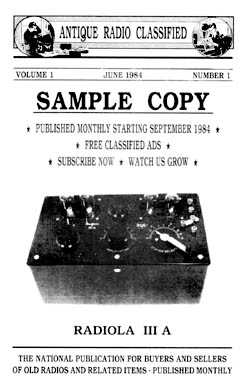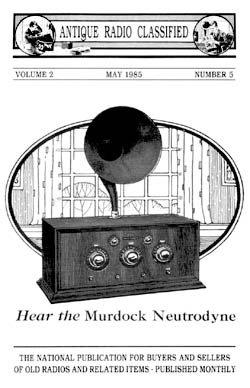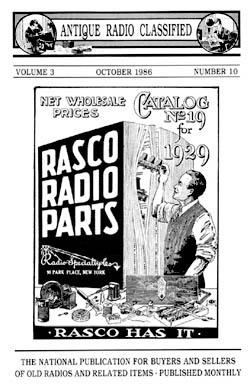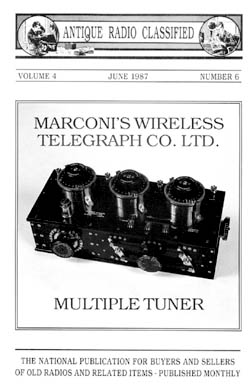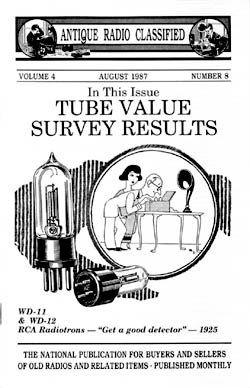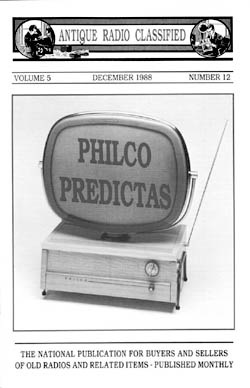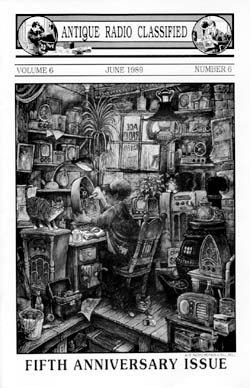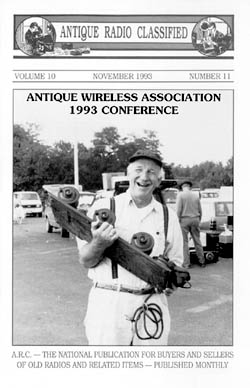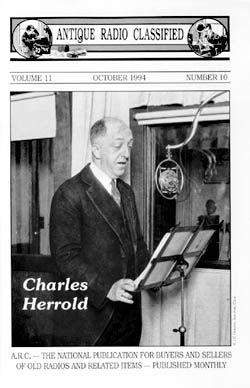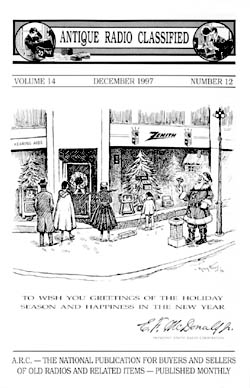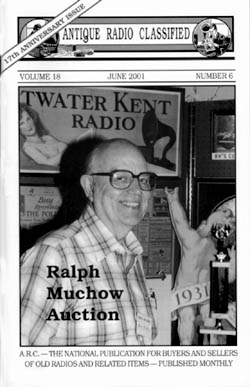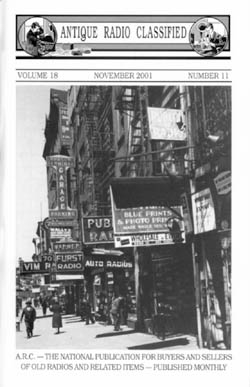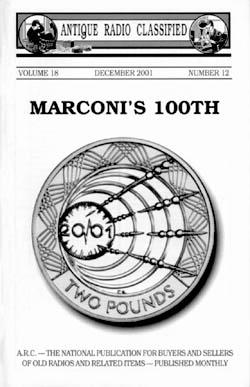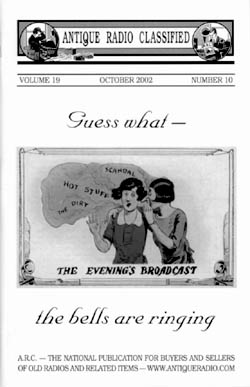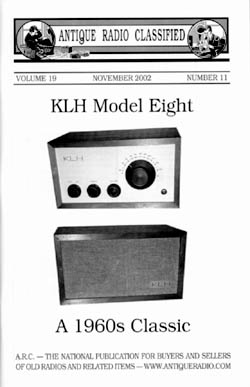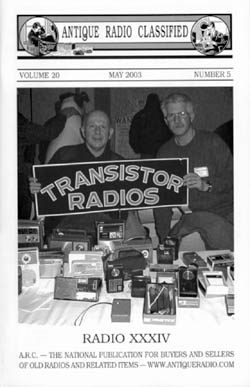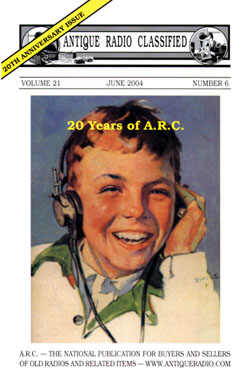Of Old Radios And Related Items--Published Monthly
A.R.C. -- The First 20 Years
BY DOROTHY SCHECTER
Web Edition
Anniversaries deserve special notice. On our tenth anniversary in June 1994, A.R.C. founder Gary Schneider contributed an article entitled "A.R.C. -- The Beginning." In it, he describes his pleasure in the growth of A.R.C. in those early days. In June 1999, we celebrated the first 15 years in an article with a number of cover photos as illustrations. And now the 20th -- a true achievement for A.R.C., champion of all things radio. (Editor)
What a difference a day makes -- so says the old song. But, how about 20 years! For a small specialty magazine, this is a milestone to celebrate. Yes, like the rest of the publishing world, we have seen many changes, particularly since the Internet "revolution." But, one thing remains constant -- our goal to continue to produce the premier national publication for buyers and sellers of old radios and related equipment.
Gary Schneider mailed 1,000, 16-page sample issues in June 1984. The cover says "Watch us grow," and that we have!
The May 1985 issue, with a 2-color cover, had grown to 24 pages. This cover was used on an early A.R.C. advertising brochure.
The 28-page October 1986 issue was the first issue published by John Terrey. Subscribers numbered 1,800.
The first full-color cover of June 1987 showed the Marconi Multiple Tuner restored by Art Albion for the Kreuzer collection.To achieve that goal over the years, we've met several challenges, not the least of which is the Internet and all its complex ramifications. In pre-Internet days, A.R.C. was the way to contact other collectors. Through clubs, meets, visits to antique shops, word-of-mouth, potential collectors found us. They became subscribers eagerly because we brought them timely news about buying, selling, and trading, as well as informative articles, on a monthly basis. Today, the Internet can provide those features in many ways more instantaneous and at zero incremental cost, if the user already has Internet access.
As with even major publications, the Internet has made a difference to us in multiple ways. Since our 15th anniversary issue, our hard copy readership is down from just over 8,000 to just under 5,000. However, the ironic twist is that we average over 1,000 visitors a day on our Web site. In fact, the March '04 statistic was 1,246 per day. These visitors access selected articles, both current and archival, radio events pages and club listings, and the last three months of classified ads. Access is free except for the most recent ads reserved for subscribers.
The August 1987 issue presented the results of the tube survey, one of several surveys conducted by A.R.C.
Television has not been neglected as indicated by this December 1988 cover showing a Philco Predicta TV.
Perhaps our most memorable cover is Bill Bell's "Ace Radio Repair," printed in full-color in June 1989.We have a duo dilemma: Our success lies in the fact that more people are reading A.R.C. and benefiting from A.R.C. perhaps than ever before in 20 years; our challenge is to get all to pay for it in this global environment of free access to information.
Looking Back
We look forward to meeting this continuing challenge, but an important anniversary always prompts reflection on the past. Twenty years is a long time and A.R.C. has made a very long journey since June 1984 when Founder Gary Schneider sent a 16-page sample as a trial balloon to 1,000 prospective subscribers.
In September 1984, the premier issue went to 440 subscribers. By August 1986, shortly before John Terrey took over the then 28-page publication, the number had grown to 1,817. A check of the fifth anniversary issue statistics shows that 4,500 subscribers were then in the fold, and by 1999, we hit the over 8,000 mark.
What accounted for this growth? Five factors come to mind: 1) More widespread advertising of A.R.C. in over a dozen collector publications; 2) Free samples to interested collectors and even to some who own only one radio, which, as a result, often ended up in the hands of a serious collector via the A.R.C. free sample. Since 1986, we have sent out over 81,000 free samples; 3) A.R.C. booths at radio meets and Ham gatherings from coast-to-coast -- from the big states like California and Texas to the smallest, Rhode Island. We have even set up at the meet in Birmingham, England. 4) A consistent, quality magazine. 5) Loyalty of our subscribers. Annually, our renewal rate is nearly 80 percent. In fact, of the 1,817 subscribers when John Terrey took over the magazine, 466 still subscribe today, eighteen years later! As our subscriber list, ads, and articles have indicated, A.R.C. is known and respected internationally.
Reports on radio meets and auctions have been staples in A.R.C. This 100-page issue went to over 8,000 subscribers.
Many issues have featured a story on a historic manufacturer or personality, such as Charles Herrold.
Seasonal covers have always been popular--Christmas, Valentine's Day, Halloween, and the baseball season.The Human Side of A.R.C. History
Growth and meeting the technical challenges of the modern world are not the only topics of a historical perspective. What is really interesting and meaningful is the human side of the story. Who and what twists of fate have made A.R.C. what is today?
Gary Schneider's idea that there was a need for a way to connect "collectors of old radios and related items for purposes of buying and selling" points directly to today's Internet exchanges for the same purposes. By 1986, A.R.C. had grown so that Gary realized he could not give it the necessary time needed, and he began to return renewal subscription money.
Luckily, that process was stopped by a chance meeting with John Terrey at the 1986 Radiofest in Elgin, Illinois. A deal was finalized late one evening at the bar. Encouraged by many people at the meet, John announced at the banquet that he had agreed to purchase A.R.C.
Now why would a seemingly sane electrical engineer, who had worked for over 20 years for an aerospace company, make such a choice? Well, first the radiobug had bitten with a vengeance long ago in his teenage years. The disease has proved incurable.
The June 2001 issue featured a preview of the Ralph Muchow Auction, the first million-dollar old radio auction.
The lead article in the November 2001 issue was "Radio Row Then and Now," responding to the tragedy of 9/11.
Three articles in the December 2001 issue celebrated the 100th birthday of Marconi's first transatlantic transmission.In addition, John had been considering a more technical publication and even had drafts of articles ready. Also, his interest in early technological history had evolved into a plan for an antiquarian technical book business. But, the lure of a publication already established with a potential for growth was too compelling.
Early Production and Staff
The purchase was the easy part. Then came the nuts and bolts of producing a monthly magazine out of the editor's house in the woods of rural Carlisle. The early staff was made up of townfolk who had "mother's hours." The first were Mary Annavedder and Betsy Dumka, both "stolen" from that well-known local newspaper, the Carlisle Mosquito. Others like Shirley Sauer and later, Jean Meldonian followed. Many of you will remember Chris Frederickson, our Radio Events Editor, who stayed for ten years before moving to California. Laura Katz, who has also moved on, took up Chris's tasks, among others.
Within a few years of the beginning, full-time help was required. Scott Young was hired and stayed for ten years as Production Manager. Lisa Friedrichs signed on as Office Manager and stayed for seven years. Dick Desjarlais joined us as a valued technical editor.
John's next-door neighbor, Bobby Lyman, with us almost from the beginning, 1988, is a reminder of the days when Hurricane Bob struck in August 1991. A.R.C.'s "office" in the woods was one of the last to have power restored, and we were forced to transfer the operation to Bobby's basement. Other storms and dilemmas have stranded us at home or work, but we haven't missed a date with the printer yet.
A vivid memory of that early time is "Aerobic Day" when the entire press-run of magazines, weighing about one-half ton, was carried up a flight of stairs to John's kitchen. There the mailing process of sticking on labels and stamps took place. How different from today when our Macintosh-produced pages are delivered on a disk to our printer and then labeled and mailed by a nearby mailing house.
On the October 2002 cover, the bells were ringing for the wedding of Editor John Terrey and Sarah Ford.
The classic KLH Model Eight graced the cover of the November 2002 issue showing that 1960s radios are "old" radios, too.
Non-auction events, such as the Westford, Mass. Radio XXXV reported on in the May 2003 issue, continue to be successful.Perhaps our first major milestone was the move out of the Terrey house. February 22, 1992, was the memorable day when we took over the first floor of one of the few commercial buildings in Carlisle. Though certainly not noted for its splendor or amenities, the building, originally a molasses factory, afforded us plenty of space. We acquired office, shipping and storage space, and room for our computers, as well as for the old radio (or two or three) that inevitably kept popping up. This move seemed to be a giant step in professionalizing the magazine -- we were no longer a "cottage industry."
Still, we retained that most important dimension to the human side of producing this unique magazine -- the contribution of many writers. Over the years, bylines of well known collectors have appeared on our pages -- Frank Heathcote, Dave Crocker, Jim Kreuzer, Ralph Williams, Frank White, Jim Fred, Richard Foster, Ian Sanders, Howard Stone, Ray Bintliff, Dick Desjarlais, Alan Douglas, Paul Joseph Bourbin, Norman Braithwaite, Ray Chase, and Richard Arnold. Our apologies to others too numerous to list here. Each year, we're delighted to add more contributors to A.R.C., and our readers seem to take great pleasure in the diversity of their topics.
The More Recent Past
Since our 15th anniversary issue (June 1999), A.R.C., again, has seen changes in location and personnel. We have moved from the old molasses factory back to our original location, albeit in the transformed garage section of John Terrey's home.
As many of you may have experienced, it's been our good fortune to have Pat Wedge join us as our office manager in these last two years. Longtime layout artist Dave Crocker has retired for about the third time, as the commute from Cape Cod became more of a hardship. But, he stays on board electronically doing things like Photo Review and writing articles.
Assistant Publisher and Advertising Manager Cindie Bryan, here for ten years, juggles her multiple A.R.C. jobs with being a full-time mom to two-year old Rachel. A.R.C. may be unlike most offices in its readiness to put up the playpen for Rachel or provide the magic markers, but we wouldn't have it any other way. We recommend to all offices the pleasure of having an occasional resident baby. Unfortunately, Rachel's first word was not "radio," despite your editor's valiant efforts.
Others of the "Old Guard" remain at the helm -- Bobby Lyman, as mentioned earlier, here for 16 years; longtime collector and technical editor Ray Bintliff for 10; and yours truly as managing editor, for 14 years. Ray and I deal with the articles, doing our best to make them as accurate and readable as possible. We rely on you to contribute most of the basic material, while we also generate articles in house.
As for Editor John Terrey, most of you will recall his big news of the last five years. First, came the unveiling -- off with the 18-year beard in 2000 (see May 2001, page 19!) Then came a high school reunion in Texas, and Sarah Ford slipped into A.R.C.'s orbit. She and John were married in October 2002, and so brought together two families -- five adult children, two grandchildren, and more on the way. This is definitely a five-year success plan.
In general, the staff continues to be a good mix of engineers, collectors, technology experts, business managers, and keepers of the King's English. We are a motley crew, joined in a common cause, doing work we love to do and, we hear, you readers love to receive.
Twenty years of A.R.C. is celebrated with the June 2004 issue, the beginning of another decade.Publishing and Article Trends
Another area of success for us has been in digital publishing. We have made a good transition into that whole process, and one result has been the ease of color reproduction.
Those of you with us since the beginning will remember the December 1986 cover -- Santa's costume and the ink he writes with have a "splash" of red. But, the first full-color cover appeared in June 1987 portraying the Marconi multiple tuner. In subsequent years, we used color whenever the occasion or the subject made it irresistible, but cost was always a factor. Now digital publishing allows our color covers to be economically provided.
In these years, we also became very much a part of the story of the decade -- the tragedy of 9/11. Having long before written about Radio Row, the site of the World Trade Center, we found ourselves a resource for other media in that time of crisis. We reported on the rescue communication work of the Ham operators, as well as the actual relief work as witnessed by our editor. Knowing the history of the area and its significance to radio collectors made the story even more poignant to us all.
Another area of remarkable development in reporting opportunity has been the auction scene. In the past, there were club activities and a few annual or biannual auctions held commercially. The trend now is almost monthly auctions of real significance, and we are fortunate to have a reporter like Ray Chase covering the prolific Estes auctions and others. If there is a radio auction, Ray will be there. Other houses, like Harris and some abroad, are also including radios in their listings.
Our reports have become a prime resource for information about going values, and the remarkable change in them in recent years. In the past, high-end items were usually exchanged privately, the prices never revealed. Now high-end items show up at auction regularly. Perhaps exposure to eBay has made auctioning more palatable to collectors once wary of the process. Whatever the cause, the success of Estes Auctions is testimony to a trend that is here to stay.
The Internet Challenge
In our 15th anniversary article (June 1999) we talk about our entrance into the "Information Age" with the A.R.C. Web site established three years before. At the time, we envisioned an evolving "Grand Plan" to expand on the Net. Little did we know how difficult it would be to implement such a plan. The fact is that we haven't had the resources to design and implement the comprehensive site we envisioned.
Accepting this reality, we have elected to maintain our basic, but adequate site, rather than to add bells and whistles. We have a serviceable site that ably responds to that large number of visitors. But, we continue to value our old support base and to perform comprehensive services for them. While the Net is anonymous, A.R.C. is highly personal and continues to try to respond to individual questions and problems. We still track "bad eggs" and do our best to report on trends in the marketplace.
Though attendance at major meets has been moderating slightly in recent years, new clubs and new museums keep cropping up. Our reports reflect that there is still a strong interest out there in preservation and in the continuity of this avocation.
A.R.C. can still claim to lead in the U.S. circulation of antique radio magazines and still claim without exaggeration to be "the best." Renewals are not the problem. Attracting new paying subscribers is our challenge, and since the range of radio collectibles is expanding, we should be able to meet that challenge.
A.R.C. has come a long way in 20 years. The hope is that we can continue to thrive and to champion the cause of preserving radio history.
(Dorothy Schecter, c/o A.R.C., P.O. Box 2, Carlisle, MA 01741)
Antique Radio Prices:
The Phenomenal Escalation ThereofAdapted from a 1978 talk given by Paul Giganti
In 1989, Paul Giganti wrote: "Here is something from which you will get a kick. I had a lot of fun giving this talk 10 years ago, in 1978. If you can use it, you are welcome "
We published Paul's talk in the August 1989 issue of A.R.C. We augmented it with prices from "For Sale" lists that Paul had distributed in the early 1960s, and with then current (1989) price estimates. In this issue, we have added recent price estimates, for 2001 to 2004.
Unfortunately, Paul passed on in 1996 at the age of 86. For those of you who were not fortunate enough to meet him, Paul was what I call a "vintage collector!" As well as accumulating a superb collection of his own, he helped many, including me, add many quality items to their own collections. Today, 26 years after Paul gave the talk and 15 years after we ran it in A.R.C., the comments in Paul's article still apply, with different names, and with considerably higher prices.
It is fitting that we honor Paul again in the pages of A.R.C. with his words. (Editor)
In a way I feel partly responsible for today's high prices on old radios. When I first began to collect I made up my mind to accumulate a collection in a hurry. So, in order to attract the gear, I decided to pay high prices, such as $5 for a Grebe Synchrophase (my first set), $3.50 for an Aeriola Senior, $50 for an IP-500 (a fantastic price), and $15 for an Atwater Kent breadboard. This really blew the market, and sellers began to realize the value of the treasure in their attics.
Harold Greenwood
I met Harold Greenwood about 20 years ago when I first became interested in the old gear. Harold had already been collecting for several years and had just begun work on Harold Greenwood's Historical Album of Wireless and Radio, the first ever written on antique radio and wireless. You probably know the book as Vintage Radio, the title given it by Morgan McMahon when he took over the revision and reprinting of the book.
I recall vividly a trade I made with Harold. He had been looking for a Radiola Special, a one-tube regenerative receiver, and I had the good fortune of finding one. So I went down to see him and set the radio on his desk. We went into his garage where the floor was literally covered with his duplicates. He pointed to a Kennedy 110 and asked me if I thought that would be a fair trade. I was so shocked at such a fabulous offer that I stuttered a little. He took this to mean that I was not satisfied so he kicked a Grebe CR-8 and said how about adding this? Then I was really flustered and started to say, "Do you mean I can have both?" He pointed to a CR-5 Grebe and said he would throw it in also. I pulled myself together and said, "Yes."
A few years later, Bill Traver and I purchased the Greenwood Collection. We acquired almost everything in the book, a total of about 300 pieces, including all the tubes for the receivers. The price of the collection was $3,000 or $10 per unit. Mind you this included Marconi, DeForest, RCA, Grebe and at least five Atwater Kent breadboards. I kept what I wanted and readily disposed of the rest. I even sold a DeForest tuner to the Smithsonian Museum.
I recall another incident which occurred during the Depression. A friend and I walked into a junk shop in Chicago and spotted a Grebe CR-8 receiver. The price was $1, so we chipped in 50¢ each, took the set home, and sawed it in half. I wanted the variocoupler for a crystal set, and he took the rest. Today I would be shot for such a sacrilegious act.
Antique Radio Pricing
The price of antique radios is determined by several factors: 1. How anxious the buyer is to possess the object. 2. How reluctant the seller is to part with it. 3. Then there is inflation. We do, however, have a personal guide based on previous experience. For instance, if a radio is priced at $100 and does not sell, obviously the price is too high. In a few exceptional cases, raising the price might cause it to move. Some buyers are not attracted to a piece that is, in their opinion, too "cheap."
Some sets, for no apparent reason, seem to skyrocket in value. One of these is the Atwater Kent breadboard. Today this is a very popular set and in extreme demand. About five years ago, I had 12 breadboards in my garage, priced at $35. They did not move. Nobody seemed interested in them as they were too "modern." Finally they went, one by one.
Last month I was broker on a sale of an Atwater Kent Model 5. The price -- $1,320. What happened to cause this sudden jump in value of a rare version of a breadboard that not too many years ago sold for $85? I can tell you why. A collector in Illinois had a duplicate Atwater Kent Model 5 which he was holding for trade. A certain collector in California, made him an offer he could not refuse -- $1,000 -- at that time, the highest price ever paid for any Atwater Kent breadboard. This set a precedent. From then on, any collector with an Atwater Kent 5 would take no less. I ask you, who is to blame for this state of affairs, the buyer or the seller?
Dealers
At this point I would like to say something in defense of the dealer, one of whom I happen to be because I have to eat. Some collectors take a dim view of dealers in our hobby and tolerate them as a necessary evil. I once visited a collector who told me that I was not a good collector because I sold things. I pointed to a Radiola III on his shelf and asked if he would take $1,000 for it. He said "yes". So then I told him that the only difference between us was that his price was higher than mine.
Three-Dialers
A word on three-dialers. I know a lot of collectors don't care for them. Don't sell three-dialers short. Some of them are quite beautiful and can make a good addition to any collection. I notice some of the new collectors only want Marconi, DeForest, Atwater Kent breadboards and Wireless Specialty. They might as well ask for the moon. The good thing about three-dialers is that they have not as yet been affected by inflation. Prices are as low as $25.
Tulips
In conclusion, I would like to tell you a story. It is true and happened over 300 years ago in Holland. Holland, as you know, is famous for tulips. The flower became so popular that the bulbs were selling in a commodity market, similar to our Board of Trade. (You know what a Board of Trade is -- I visited the Board of Trade Building in Chicago years ago. This enormous room was filled wall-to-wall with people who were screaming, shouting and shoving each other. What were they doing? They were selling wheat and corn, which had not even been planted yet.)
On with the tulip story. People were mortgaging their homes and buying tulip bulbs on speculation. Soon the price reached $2,000 for a single tulip bulb. One day, at the town meeting a wise old man got up and said, "Folks, let's face it, no tulip bulb is worth $2000." At that moment the market collapsed, and a great many people lost their shirts and maybe their pants too. Wonder what would happen if some wise man would say, "No old radio is worth $2000."
Reference: "The Phenomenal Escalation Thereof." A talk given before the Southern California Antique Radio Society in Redondo Beach, Ca., by Paul Giganti, October 3, 1978
Forty years of Old Radio Prices
By John V. Terrey
Web Edition
In a collection which I purchased quite a few years ago, I ran across several "For Sale" lists titled: "Harold Greenwood Collection of Antique Radio and Wireless Equipment" dating from Feb. 1, 1963 to March 15, 1965. These lists had been sent out by Paul Giganti when he was selling items from the Harold Greenwood collection. In fact, items from this collection still exchange hands today, and can be identified by Greenwood's green identification tag, usually found on the bottom of the item.
In 1989, A.R.C. ran Paul's 1978 talk above, along with a comparison of prices from Paul's mid-1960s prices with then current (1989) prices. The 1989 prices were compiled by Jim Kreuzer who contributed the "A.R.C. Value Guide" series from 1984 to 1986.
For this 20th anniversary issue, we again run the table from 1989, but with the addition of recent prices based on auction prices reported in A.R.C. over the last few years, and, estimates by Jim Kreuzer.
Collectors, enjoy looking over these old prices. Most of the items are now worth many times their 1960s prices, and in the case of rare items, many times their 1989 prices.
Which brings me to my theory of collectible value behavior: Some years after an item is sold new, it becomes obsoete and becomes "junk." However, 30 to 40 years after being sold new, individuals in their 40s to 50s, now having more time and money on their hands, remember these items as things they had wanted when they were young, but couldn't afford. What happens is that "junk" evolves into "collectibles," and prices of both common and scarce items, grow from junk levels.
Then, because of the higher prices, more junk (whoops, collectibles) comes out of attics, basements, barns and garages, and the additional supply moderates price growth, especially for common items. During this maturing period, some items even fall in price. Examples of this price behavior can be seen in some of the the Atwater Kent and Crosley sets where prices grew at about a 10 to 15 percent annual rate from the mid-1960s to 1989, the "junk-to-collectible period," but changed very little from 1989 to the present, the "maturing period."
However, for scarce sets, during this maturing period, prices continue to rise because of collector demand the supply cannot increase significantly. Examples exhibiting this continuing demand-driven price growth are the Canadian Marconi set, the Connecticut Sodion receiver and some of the the Kennedy sets. The important point here is "collector demand," because there are other sets, though rare, that just don't seem to be collectible.
And then there are the super rare and super collectible sets, such as the C.R.L. Paragon PAR which has increased in price over 200 times since the mid-1960s. And there are the special situation sets, exemplified by the Western Electric 25B amplifier, now desired by audiophiles, increasing 140 plus times.
Not included in this table, primarily because the Greenwood collection consisted of 1920s battery sets, are the Art Deco mirror and Catalin sets which also demand high prices today. A Sparton Nocturn, a rare 54" round blue mirror set, recently brought over $80,000 at an auction. Also, early wireless items such as the versions of the Marconi 106 and the IP-500/501/501A type of sets are enjoying $5,000 to $20,000 prices on a regular basis.
But, prices alone are not the measure of the value of a collection. As Paul Giganti said in 1978, "Don't sell three-dialers short... Prices are as low as $25." And, even today three-dialers are selling for only $50 to $75.
My personal collection proudly displays three-dialers alongside rare battery and wireless sets, and it even has a representative Sparton blue mirror and Fada Catalin. Collectors, ignore the values on this list and ignore the published price guides; determine the value of your collection as what it means to you. (Editor)
Radio Prices mid-1960s to early-2000s Notes for table on opposite page
(1) Paul Giganti's "For Sale" lists for the Harold Greenwood Collection from Feb. 1, 1963 to March 15, 1965.
(2) Furnished by Jim Kreuzer who contributed the A.R.C. Value Guide series from l984 to 1986.
(3) Based on 2001 through 2004 auction reports and estimates from Jim Kreuzer and A.R.C.
Radio Prices mid-1960s to early 2000s
Description Price Value Value '63-'65 1989 '01-'04 (Note 1) (Note 2) (Note 3) Airphone 1-tube receiver $15 $175 $200 Airphone 1-tube amp 15 225 275 Amrad Variocoupler unit 12 180 300 Amrad V.T. Detector Unit 12 180 325 Atwater Kent Model 20 15 55-75 95 Atwater Kent Model 30 10 50 80 Atwater Kent Model 10 50 400 950 Atwater Kent Model 12 50 750 1,650 Atwater Kent Model 9 75 300 1,500 Canadian Marconi, 3-piece 80 950 4,400 Connecticut Sodion receiver 40 375 1,600 C.R.L. Paragon Type PAR 75 2,000+ 14,000+ Crosley 50, 1-tube 30 100 140 Crosley 51, 2-tube 20 85 110 Crosley VI 30 200 220 Crosley XJ 35 175 100 Crosley Trirdyn 25 85 85 DeForest T-200/P-300 135 1250 2500 DeForest D-10 with loop 55 350 810 DeForest Model F-5 receiver 35 150-275 400 Eagle Neutrodyne receiver 40 60 140 Federal Model 59 75 575 1150 Federal Model 61 100 800 1350 Federal Model 110 75 400 750 Freed-Eisemann NR-5 20 75 80 Freed-Eisemann NR-7 20 75 100 Grebe CR-9, 3-tube 50 300 450 Grebe CR-5, 1-tube 50 400 630 Grebe Synchrophase MU-1 20 130 210 Kennedy Type 220 50 600 1400 Kennedy Type 110 75 700 1500 Kennedy Type 525 amp 35 340 900 Kennedy Type 281 & amp 65 700 1200 Kennedy V 30 275 400 Lemco crystal set 10 75 150 Magnavox Telemegafone 35 200 300 Magnavox 2-stage amp 30 250 600 Marconi Type D tuner 150 2500+ 15000+ Marconi Magnetic Detector 350 4000+ 22000+ Michigan 1-tube receiver 20 175 210 Monarch crystal set 10 135 170 Paragon RA-10 & DA-2 110 700 1700 Paragon RA-6 75 3000+ 25000+ Pilot 3" television 40 225 300 Radiola 26, w/loop & base 35 360 550 Radiola 24 w/loop 25 275 475 Radiola Grand 50 550 750 Radiola III & amp, NT 25 175 250 Radiola IIIA, NT 15 120 110 Radiola IV 25 425 750 Radiola UZ-1320 horn 10 100 120 Tuska 225, 3-tube 35 200 450 West. Aeriola Jr. 35 190 330 West. Aeriola Sr., 1-tube 20 115 150 WE 4D 40 400 1000 WE 7A amp 15 140 460 WE antenna unit 25 250 1400 WE 25B amp. 10 110 1200 Zenith 3R 40 300 400 Zenith Super VII 65 160 280
| [Free Sample] [Books, etc., For Sale] [Subscribe to A.R.C./Renew] [Classified Ads] [Auction Prices] [Event Calendar] [Links] [Home] [Issue Archives] [Book Reviews] [Subscription Information] [A.R.C. FAQ] URL = http://www.antiqueradio.com/Jun04_Schecter_Twenty.html Copyright © 1996-2004 by John V. Terrey - For personal use only. Last revised: May 31, 2004. For Customer Assistance please contact ARC@antiqueradio.com or call (866) 371-0512 Pages designed/maintained by Wayward Fluffy Publications
Antique Radio Classified |
